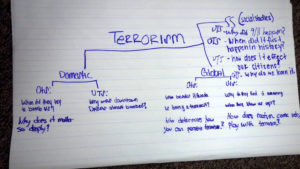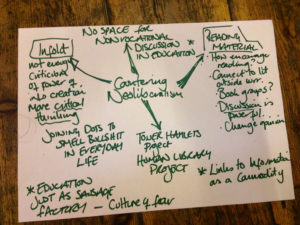When I was going into 5th Grade, my friends and I called an emergency meeting. We had been assigned to Mrs. Cottingham’s class and everyone knew she was strict… and mean. Three of us, aged 10, were all lying hopelessly on Reagan Renniger’s bed, bemoaning our fate. We didn’t even notice or care yet that we were going to get to be in the same class together, for the first time ever. We were panicked. We were doomed.
Mrs. Cottingham did turn out to be demanding, but her reputation for meanness seemed to stem from the fact that she had a blond streak in her otherwise long brown hair – like Cruella De Vil. Pretty soon, we all agreed it was much ado about nothing, and HEY, we were in the same class! It was going to be neato. Peachy keen. (We really said those words.)
This was before OUTLINING. The one thing I remember the most from that school year was that in Social Studies we had to sign a contract. If you wanted an A (and who didn’t?) you signed the A contract and did the A work. The A work included a full outline of your paper – before you wrote it. I think my assignment was a paper and presentation on Vasco De Gama.
Outlining was the bane of my existence. It required decision-making, order, organization. I could not achieve that before writing. I wrote, rewrote and then outlined from the finished product. It was the only thing I could do. My brain didn’t work that way.
Sadly, mind mapping I didn’t know about mindmapping. It was made popular in 1974 on PBS by Tony Buzan. I want to share how to mindmap, because my 10 year-old self still needs to rescue people who are suffering under the tutelage of Mrs. Cottingham (who is like 78 or 80 by now) whether in a classroom, or stored as a mean, demanding voice in your head.
how to mindmap
Mindmapping is a stream of consciousness outline that flows from a central idea. In your first map, you are simply capturing ideas, radiating from the core or title of what you’re trying to write or map.

mindmap.flickr_torres
This is a school kid’s mindmap about terrorism. You can see it’s pretty well organized, and her thoughts flow naturally onto the page. (Looks like she’ll be able to write a kick-ass paper about Terrorism. To be honest, I don’t know who “Torres” is – he could be a New York Times reporter, but this is his/her mindmap on Terrorism.)
Mindmaps have several things in common:
- There is an organizational structure that radiates from the center and uses lines, symbols, words, color and images.
- This way of thinking mimics how ideas come to us, one idea leading to another, sometimes in no particular order.
- The colors and shapes help engage higher thinking which makes a simple mindmap lead to a better outcome than a complicated, deadly, no-good outline.
Once you’ve captured all your ideas – in whatever order they come to you – it is easy to see how they relate, and how to organize them into an essay or story or speech. You can organize those thoughts as they come to you (if that works for you) or number them once they’re all on the page, and you have a defacto outline with order, points and sub-points. (Take that Mrs. Cottingham.)
The mindmap mirrors your own radiant or natural thinking process and engages you with a powerful graphic process. It naturally unlocks your brain’s potential.
all mindmaps share 5 characteristics
- There is a central idea – often written in a circle in the center of the page, like the hub of a wheel.
- There are main themes that radiate from the central idea with connecting lines or arrows, like spokes of the wheel.
- Each spoke has its theme written on its line
- Once you have the main themes, written on the “spokes,” sub themes and points are added in circles branching out from that spoke.
- Colors and graphics help make the mindmap effective for thought organization.

mindmap.flickr
to make a mindmap
Use a blank, unlined piece of paper, and have colored markers on hand.
Write your main concept in the center. I like my thoughts to be inside circles, like a hub. Yours can be more like either of the mindmaps pictured here.
As main themes come to you, draw a spoke radiating from the hub, and write your theme or idea on that spoke.
As you have ideas for how to show or flesh out that theme, write them down, in circles, little lists or however it pleases you to see your information organized.
You may find afterward, that you’d like to reorder your spokes or main themes, and how they’ll show up in what you’re writing. The simple solution is to number your ideas, so when you sit down to write, it is easy to follow the flow of your original thinking.
I wonder if Mrs. Cottingham ever taught mindmapping.
It wouldn’t be that much longer before mindmapping became all the rage in business innovation circles. I don’t know how quickly it made its way into 5th grade classrooms. I signed my A contract, which included an outline of my paper, due weeks before the finished paper. I did mine late (after I was done writing the paper) and Mrs. Cottingham gave me a C. She said I had not lived up to the terms of the A contract. I can still feel the shame of getting a C. Not to brag, but it’s the only one I can remember getting – ever.
In the meantime, you can learn more creativity tools in the free Master Classes that are part of the Write Without the Fight Club – a paid monthly membership. The Club is a treasure trove of programs about how to activate and maximize your creativity – and these four courses are free. So join us in the Clubhouse. Be my guest.